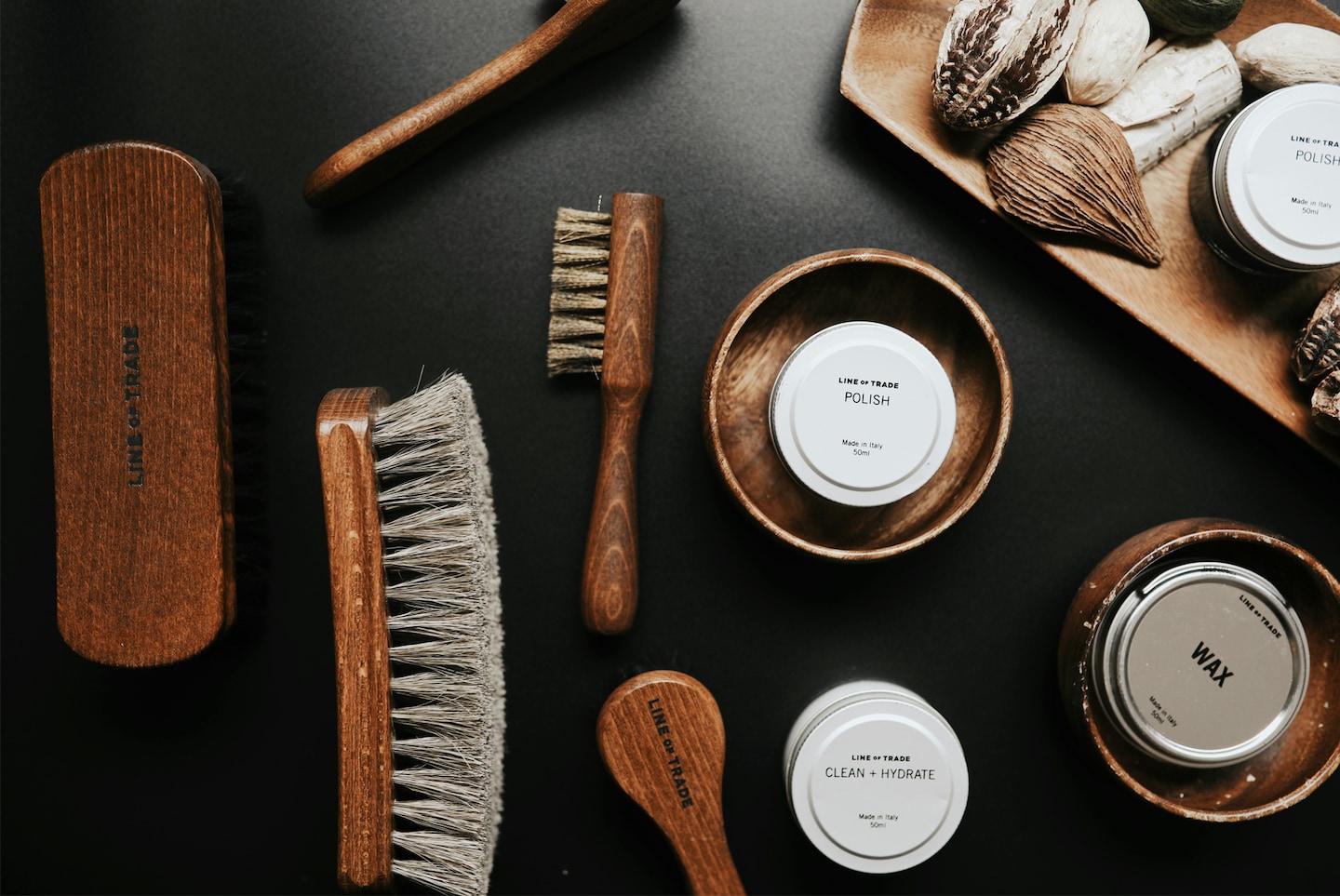
MEN’S FOOTWEAR CARE GUIDE
Keep Your Shoes Looking Sharp & Lasting Longer
Building a truly staple footwear collection isn’t just about owning stylish shoes; it’s about mastering the art of men’s footwear care. Proper maintenance ensures your favourite pairs remain comfortable, durable, and effortlessly stylish season after season. In fact, understanding how to clean, protect, and store your shoes can significantly extend their lifespan, maximising your investment and keeping them in pristine condition.
CLEANING MEN’S SHOES
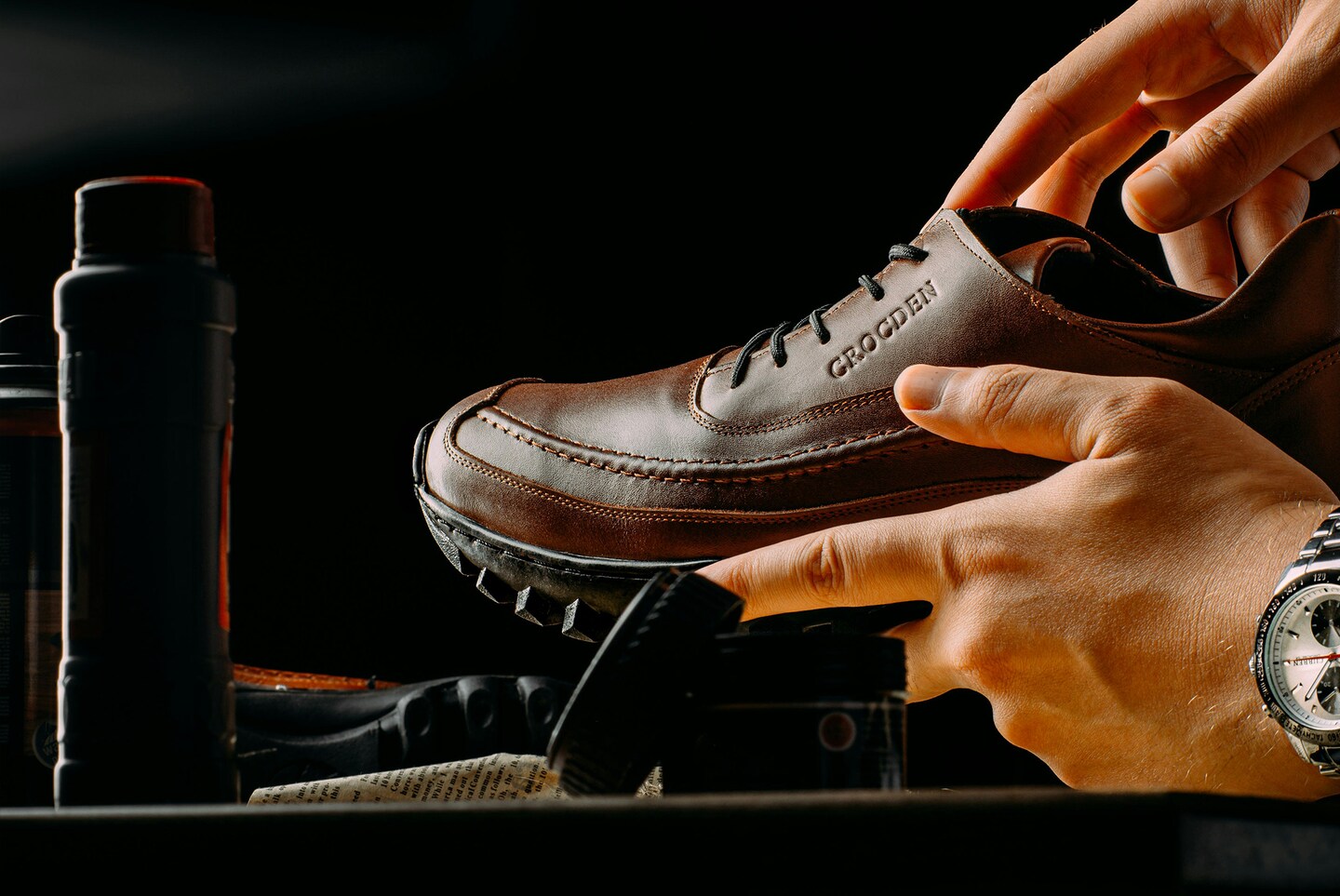
Knowing how to clean shoes is the critical first step in maintaining your men’s footwear collection. Different materials demand specific cleaning methods to prevent damage and ensure an effective clean.
Leather Shoes
-
Prevention is Key: Before the first wear, always apply a high-quality leather protector spray. This creates an invisible barrier against water and stains.
-
Routine Cleaning: Start by gently brushing off loose dirt and dust with a soft-bristled brush.
-
Deep Clean: For more stubborn grime, use a mild, dedicated leather cleaner. Apply a small amount to a clean cloth and wipe the shoe in circular motions. Avoid harsh chemicals or excessive water, which can strip natural oils.
-
Drying: Always allow leather shoes to air dry naturally, away from direct heat sources like radiators or sunlight. Rapid drying can lead to cracking.
Fabric & Canvas Shoes (e.g., Trainers, Sneakers):
-
Preparation: Remove laces and insoles – clean these separately. Laces can often be machine-washed in a mesh bag, while insoles can be scrubbed with a mild detergent.
-
Cleaning Solution: Mix a small amount of gentle laundry detergent (or a dedicated shoe cleaner for fabric) with warm water.
-
Scrubbing: Use a soft brush (like an old toothbrush) or a damp cloth to scrub the fabric gently. Focus on stained areas.
-
Rinsing: Rinse thoroughly with clean water to remove all soap residue.
-
Drying: Air dry completely. You can stuff them with paper towels to help absorb moisture and maintain their shape, changing the paper regularly.
Suede & Nubuck Shoes:
-
Specialised Care: Suede and nubuck are delicate and require specific tools. Invest in a dedicated suede brush, often with soft rubber bristles.
-
Prevention: Always apply a suede protector spray before wearing to repel water and stains.
-
Dry Cleaning: Use the suede brush to gently remove dirt and scuffs. Brush in one direction to maintain the nap.
-
Stain Removal: For stubborn marks, use a suede eraser to gently rub away the stain.
-
Drying: Air dry completely. Once dry, use the suede brush to restore the nap.
Maintaining Leather Footwear
Leather shoe care demands dedicated attention to keep your investment looking its best for years. Proper conditioning and protection are paramount.
-
Conditioning is Crucial: Regular conditioning prevents dryness, cracking, and loss of suppleness. A quality leather conditioner replenishes the leather’s natural oils. Apply every few months, or more frequently if worn often or exposed to harsh conditions.
-
Protection Against Elements: After cleaning, applying a waterproof spray designed for leather adds an extra layer of defence against rain and spills.
-
Storage Savvy: Always store leather shoes in a cool, dry place with consistent temperature. Extreme fluctuations can cause the leather to expand and contract, leading to damage.
-
Shoe Trees are Your Best Friend: Invest in cedar shoe trees. They absorb moisture, prevent creasing, and help maintain the shoe’s original shape, extending its life significantly.
Shining and Polishing Shoes
Enhancing your men’s footwear appearance involves mastering the art of shining and polishing. This not only makes your shoes look great but also nourishes the leather.
- Preparation: Always start with clean shoes. Remove any dirt or old polish residue.
Polish Application
-
Wax Polish (for a high shine): Apply a thin, even layer of wax polish with a soft cloth in circular motions. Work in small sections.
-
Cream Polish (for nourishment and softer shine): Cream polishes offer more conditioning properties and a more subdued shine. Apply similarly to wax polish.
-
Drying Time: Allow the polish to dry completely, typically 10-15 minutes.
-
Buffing: Use a clean, soft cloth or a horsehair brush to buff the shoe to your desired shine. The friction creates the shine. For an even higher gloss, a few drops of water can be used during the final buffing stages.
HOW TO CLEAN TRAINERS
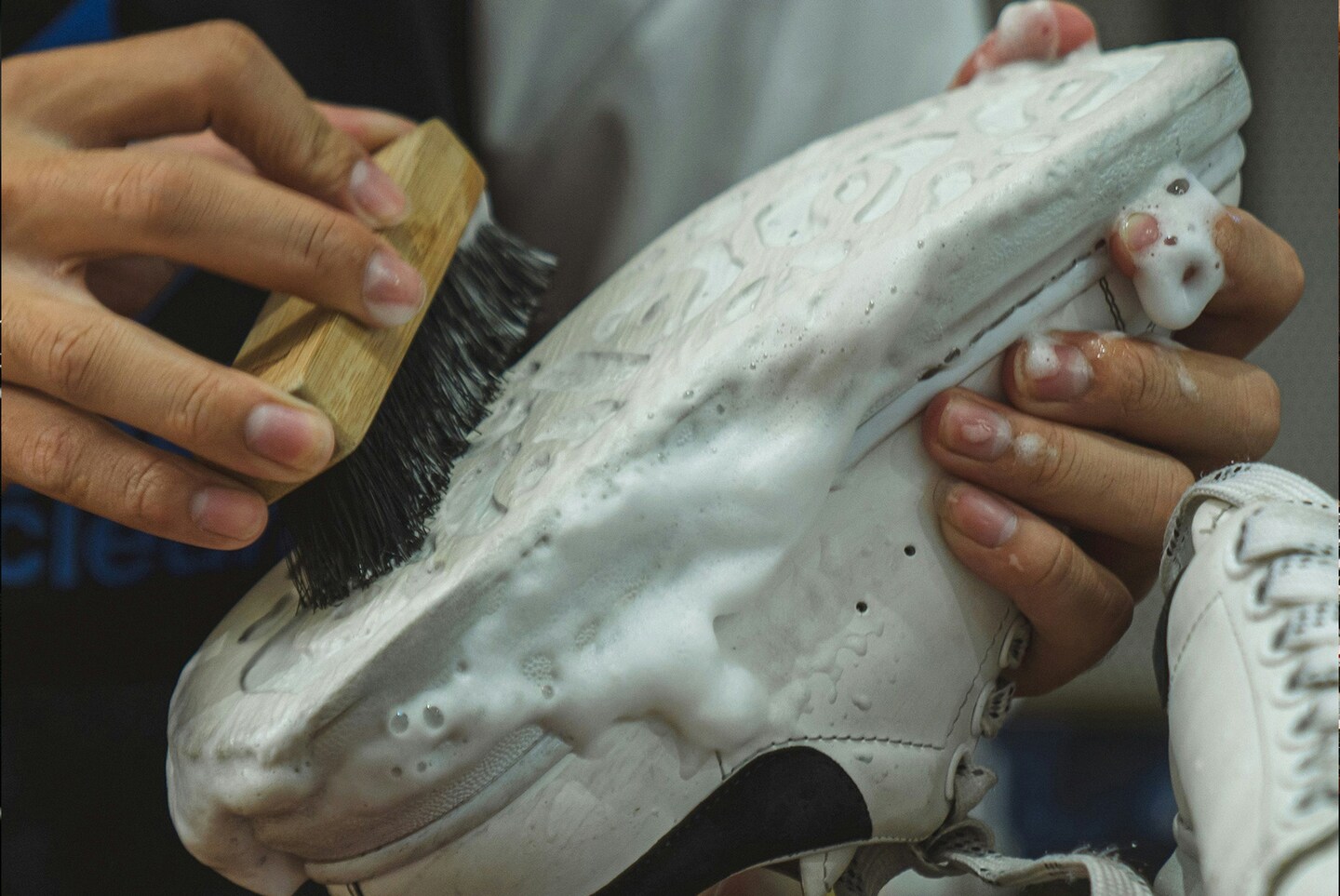
Knowing how to clean trainers is crucial, whether they’re for sport or casual wear. Here’s a breakdown by material:
Fabric/Mesh Trainers:
-
Remove laces and insoles.
-
Use a solution of warm water and mild detergent with a soft brush.
-
Scrub gently but thoroughly.
-
Rinse all soap residue.
-
Air dry, stuffing with paper towels to absorb moisture and maintain shape.
Leather Trainers
-
Wipe down with a damp cloth to remove surface dirt.
-
Apply a mild leather cleaner with a clean cloth.
-
Wipe clean and allow to air dry.
-
Finish with a leather conditioner to keep the leather supple.
Suede Trainers
-
Use a suede brush to remove loose dirt.
-
For stains, use a suede eraser.
-
Apply a specialised suede cleaner if necessary, following instructions carefully.
-
Air dry and restore the nap with the suede brush.
Essential Trainer Habits:
Rotation: Avoid wearing the same pair of trainers every day. This allows them to air out and recover.
Protective Sprays: Always use a protective spray to guard against stains and water damage.
Regular Lacing/Unlacing: Always unlace your trainers when putting them on or taking them off to prevent stretching and damage to the heel counter.
HOW TO STORE MEN’S FOOTWEAR
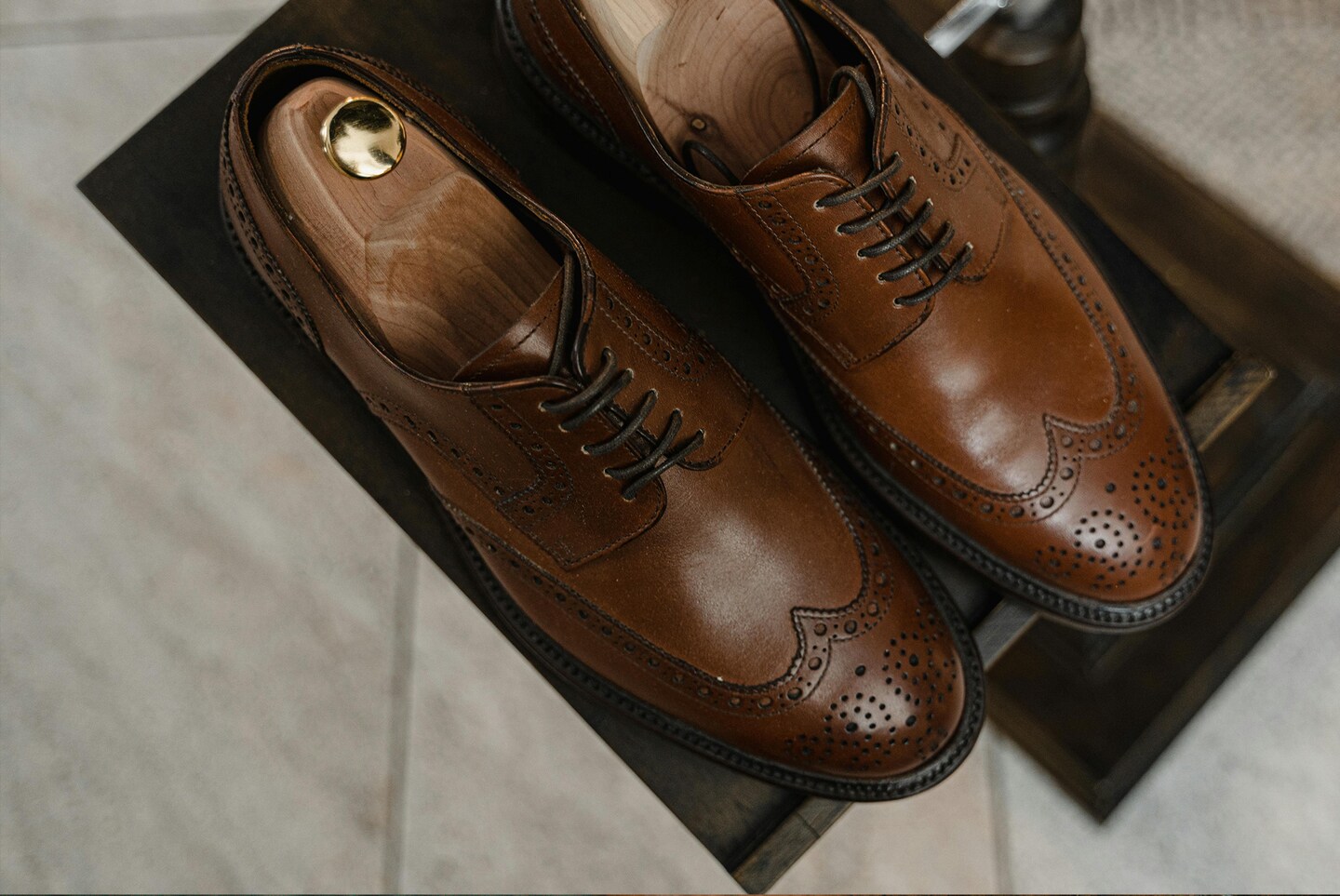
Once you’ve invested time in cleaning your footwear, proper storage is paramount to ensure they stay in top condition.
Cool, Dry, Consistent: Store your footwear in a cool, dry place with a consistent temperature. Fluctuating temperatures can cause materials to expand and contract, leading to long-term damage, especially with leather.
Dust Protection: Keep your footwear dust-free to prevent staining and dirt buildup. Store them in original shoe boxes, dedicated shoe bags, or on a shoe rack in a closet.
Avoid Piling: Never pile shoes on top of each other, as this can crush and deform them.
Shoe Trees (Again!): For dress shoes and boots, shoe trees are a must-have for maintaining shape and absorbing moisture.
Shoe Soles: Care, Repair, and When to Replace
The soles of your shoes are their foundation, providing comfort, support, and grip. Recognising when shoe soles need replacing is key to maintaining both the comfort and style of your footwear. Look for uneven wear patterns, thinning areas, holes, or visible cracking in the sole. A significant loss of grip is also a clear indicator.
Extending Sole Life (DIY Tips):
Clean soles regularly with a soft brush or damp cloth to remove embedded dirt and grit. For new shoes, especially those with leather soles, consider having a cobbler apply a thin rubber protective sole guard. This significantly extends the life of the original sole. Regularly rotating your shoe collection alleviates pressure on any single pair, allowing the soles to rest and recover. If your soles are beyond DIY repair, don’t discard the shoes! A professional cobbler can often resole shoes with high-quality materials, restoring them to almost new condition and saving you money in the long run.
FAQ’S ABOUT MEN’S FOOTWEAR
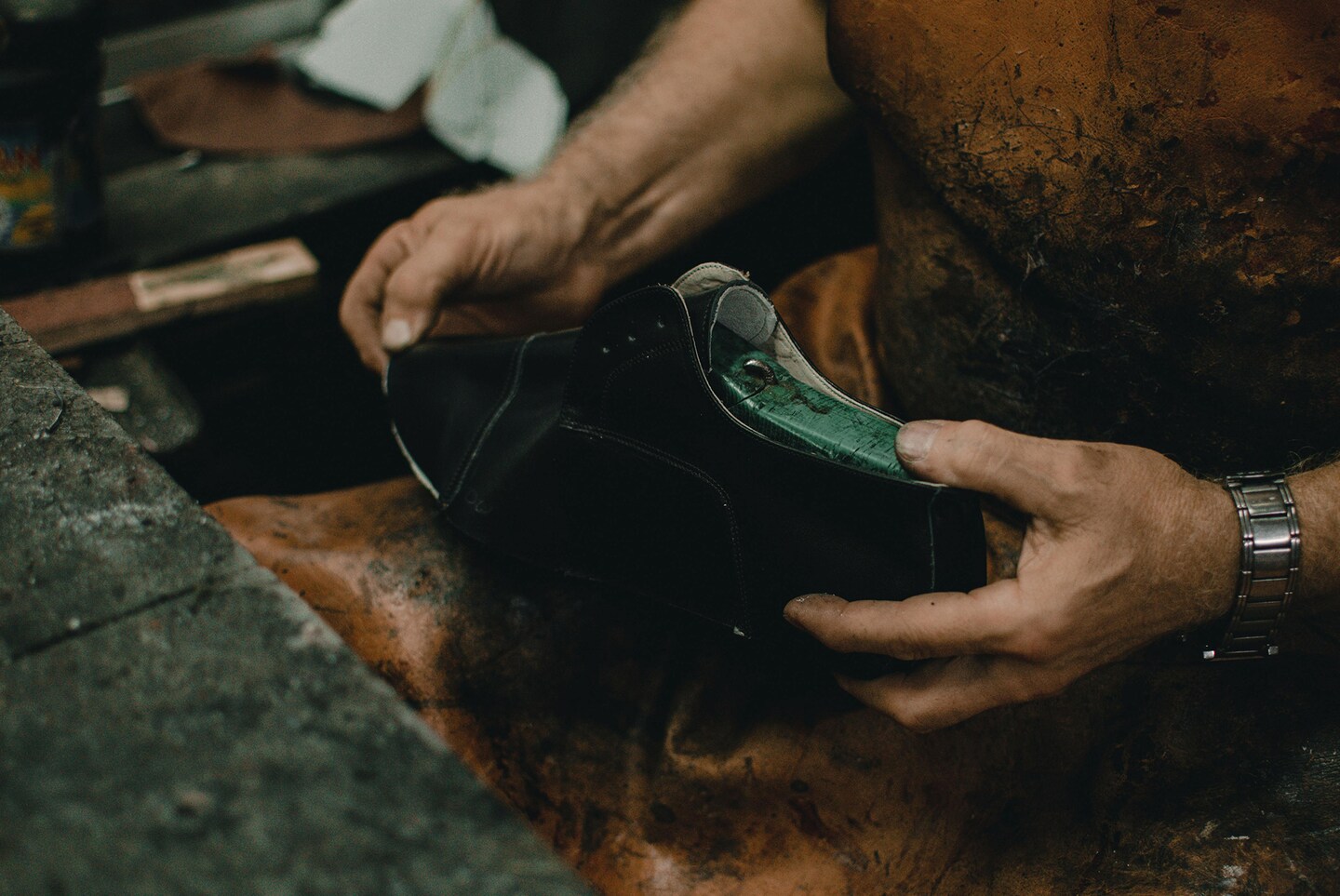
Here, we answer some of the most common queries about keeping your men’s shoes in top condition.
How often should I clean my shoes?
The frequency depends on how often you wear them and the conditions. For everyday shoes, a quick brush-off and wipe-down after every few wears is a good habit. This prevents dirt from building up and becoming ingrained. For a deeper clean (polishing leather, washing trainers), aim for at least once a month or every two months, especially if you wear them frequently. If your shoes get particularly dirty, muddy, or wet, clean them immediately to prevent long-term damage and staining.
How do I clean smelly trainers and prevent odours?
Combatting odours in trainers requires a multi-pronged approach. After each wear, remove the insoles and allow your trainers to air out completely. Avoid stuffing them into a dark, unventilated wardrobe immediately. Use dedicated antibacterial shoe sprays that kill odour-causing bacteria. Spray generously inside the shoes after each wear. Place cedar shoe balls, activated charcoal inserts, or even small sachets of baking soda (inside an old sock) in your shoes when not in use. These absorb moisture and neutralise smells. Regularly remove and wash insoles, as they absorb a lot of sweat and bacteria. Always wear moisture-wicking socks to absorb sweat and prevent direct contact with the shoe lining. Give your trainers a break! Wearing the same pair every day doesn’t allow them to dry out fully, fostering bacterial growth.
How do I prevent leather shoes from cracking?
Cracking in leather shoes is primarily due to a lack of moisture. Use a high-quality leather conditioner every 1-3 months (or more often if the leather feels dry or looks dull). This replenishes the natural oils and keeps the leather supple and flexible. Do not store leather shoes in direct sunlight, near radiators, or in very hot cars, as excessive heat dries out the leather quickly. Store them in a cool, dry place. Shoe trees help maintain the shoe’s shape and absorb internal moisture, preventing creasing that can lead to cracks.
Can I clean shoes in a washing machine?
Generally, you should be very cautious with washing machines, as they are NOT suitable for all types of footwear. Most fabric or canvas trainers (like Converse, Vans) can often be machine washed. Never put leather, suede, nubuck, or any delicate materials in the washing machine. The water and agitation will cause irreparable damage, shrinkage, discolouration, and cracking.
When should I replace my shoe soles?
Recognising when to replace soles is vital for comfort, safety, and maintaining the shoe’s structural integrity. If you notice one part of the sole is significantly more worn down than another (e.g., the heel or ball of the foot), it affects your gait and can lead to discomfort or joint issues. For quality leather dress shoes and boots, consider visiting a professional cobbler for resoling. They can often extend the life of your beloved pairs for many years.
By following these comprehensive tips, you’ll not only keep your men’s footwear looking sharp but also significantly extend its lifespan, making your investment truly worthwhile. Happy shining!